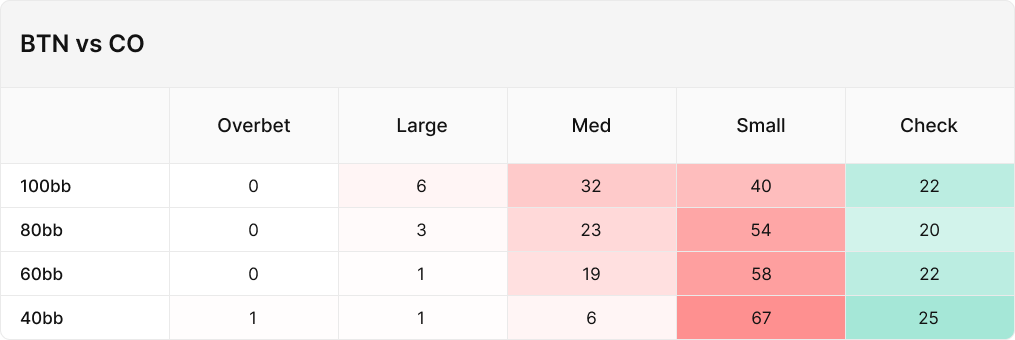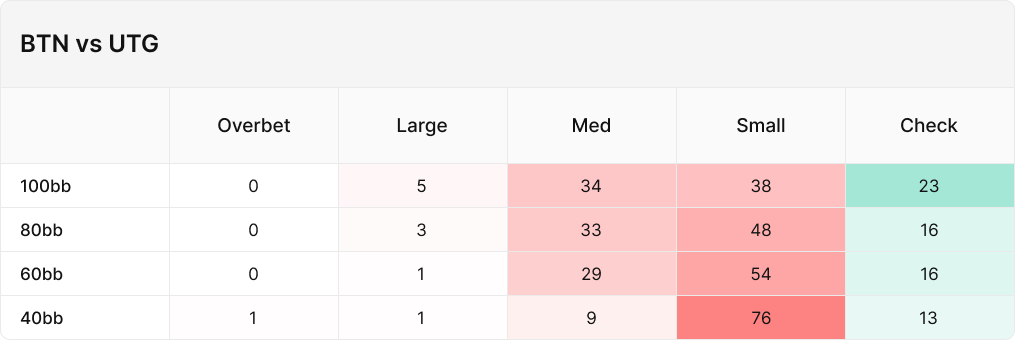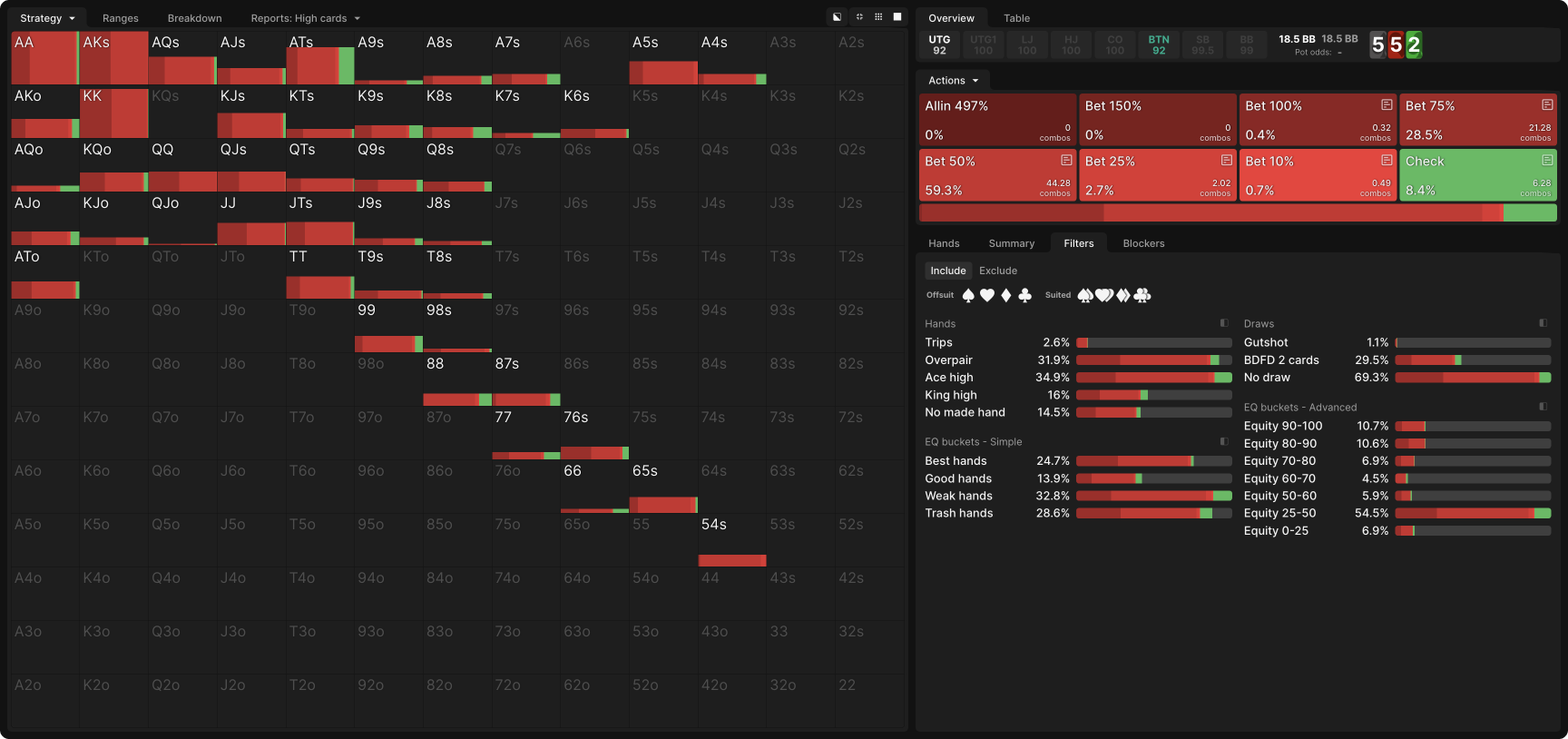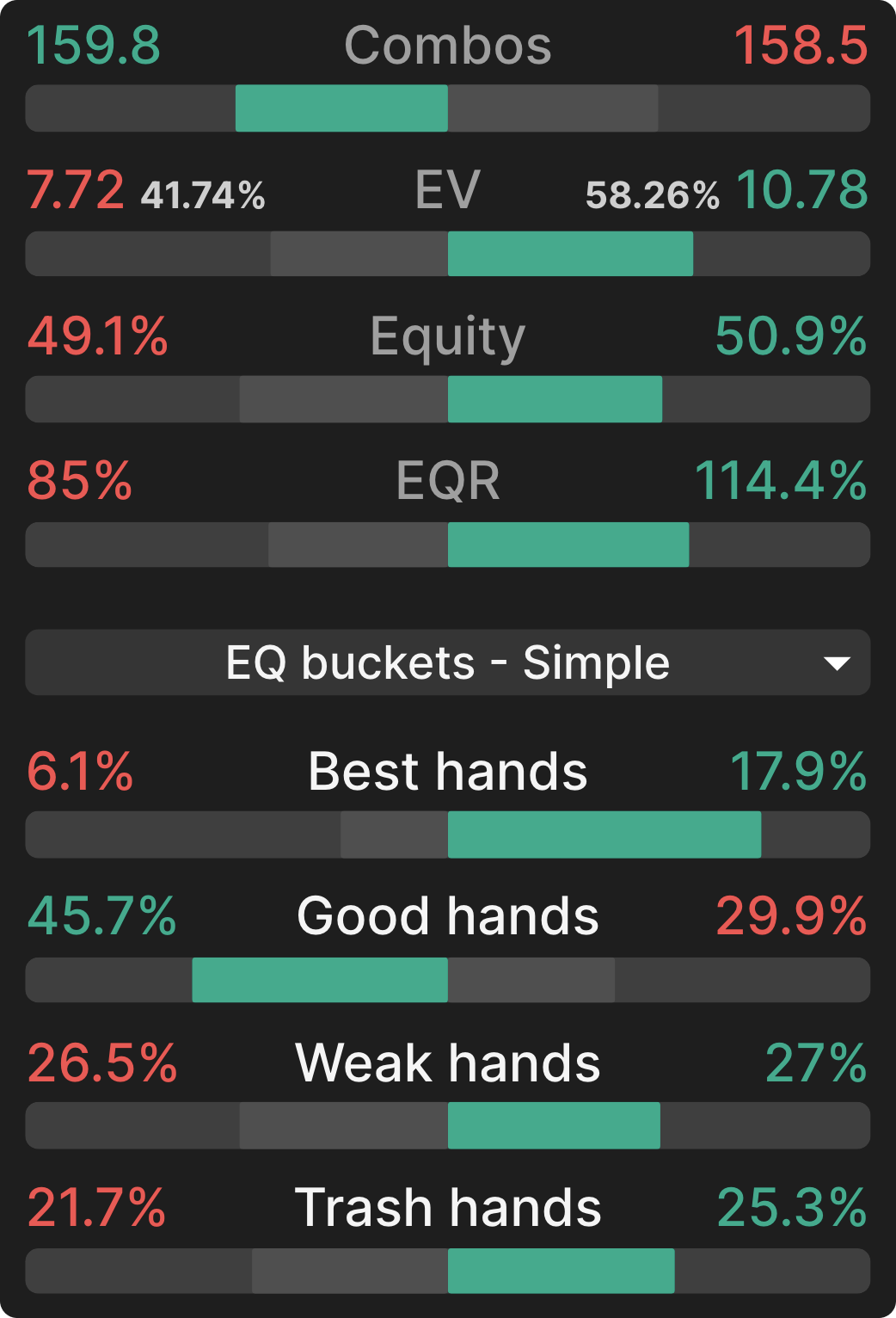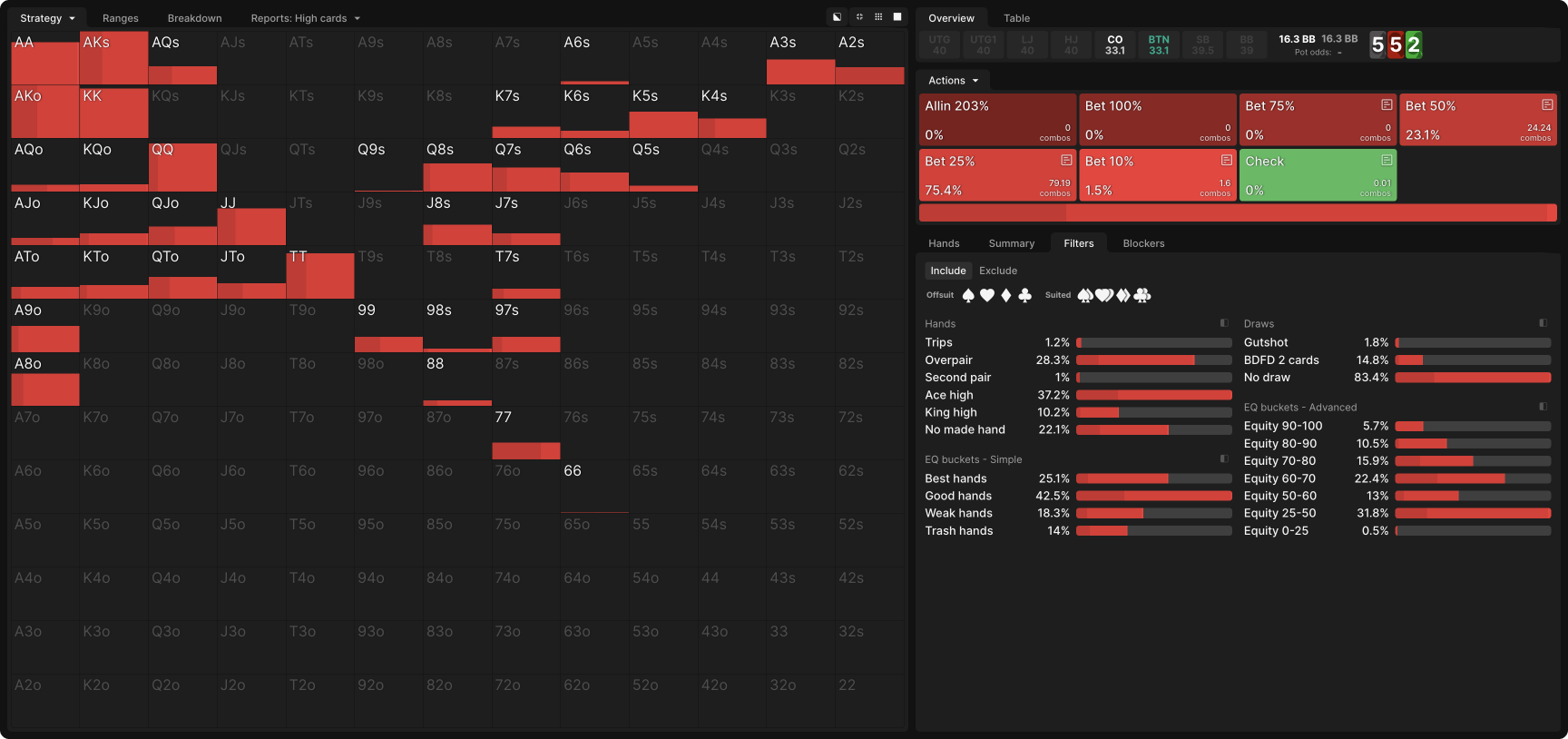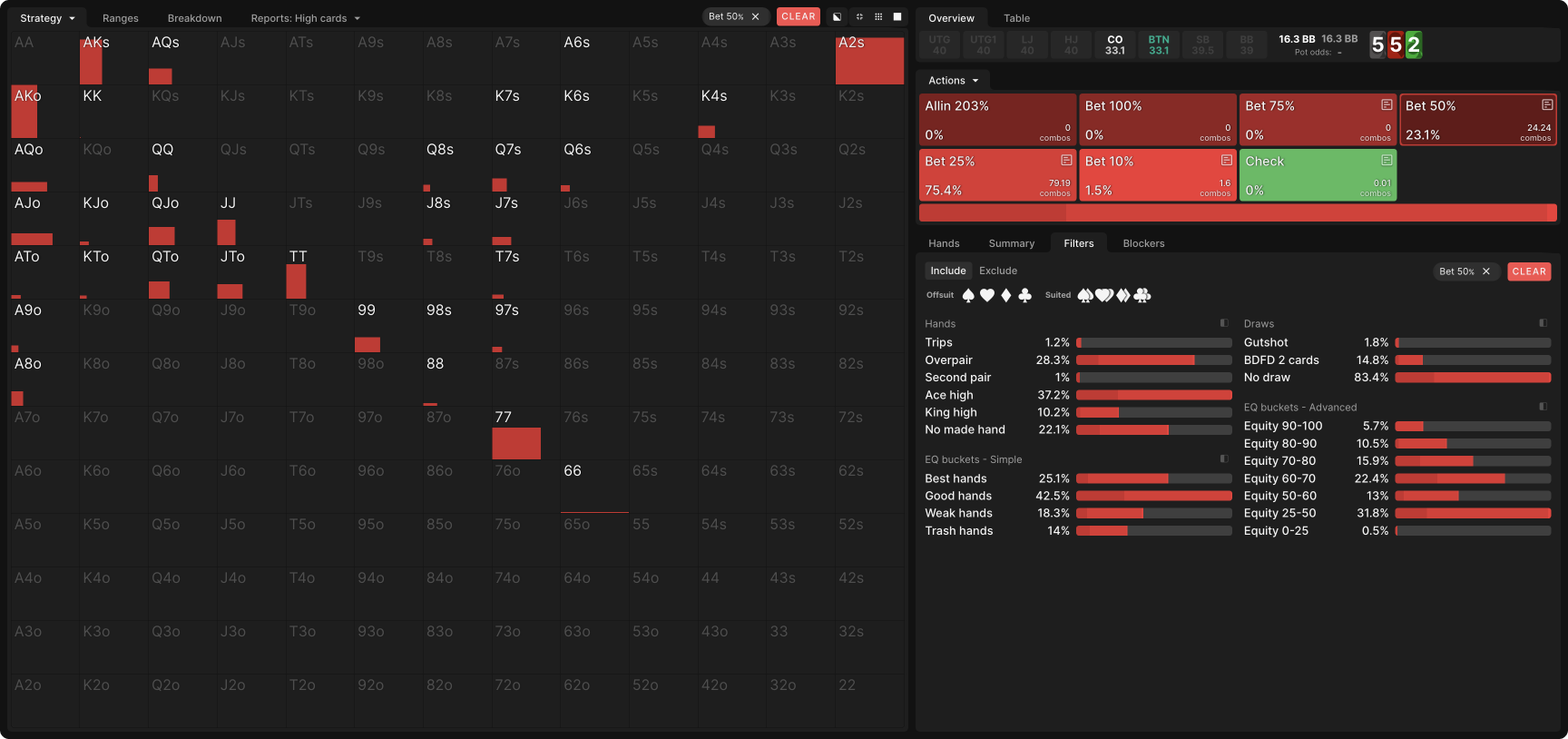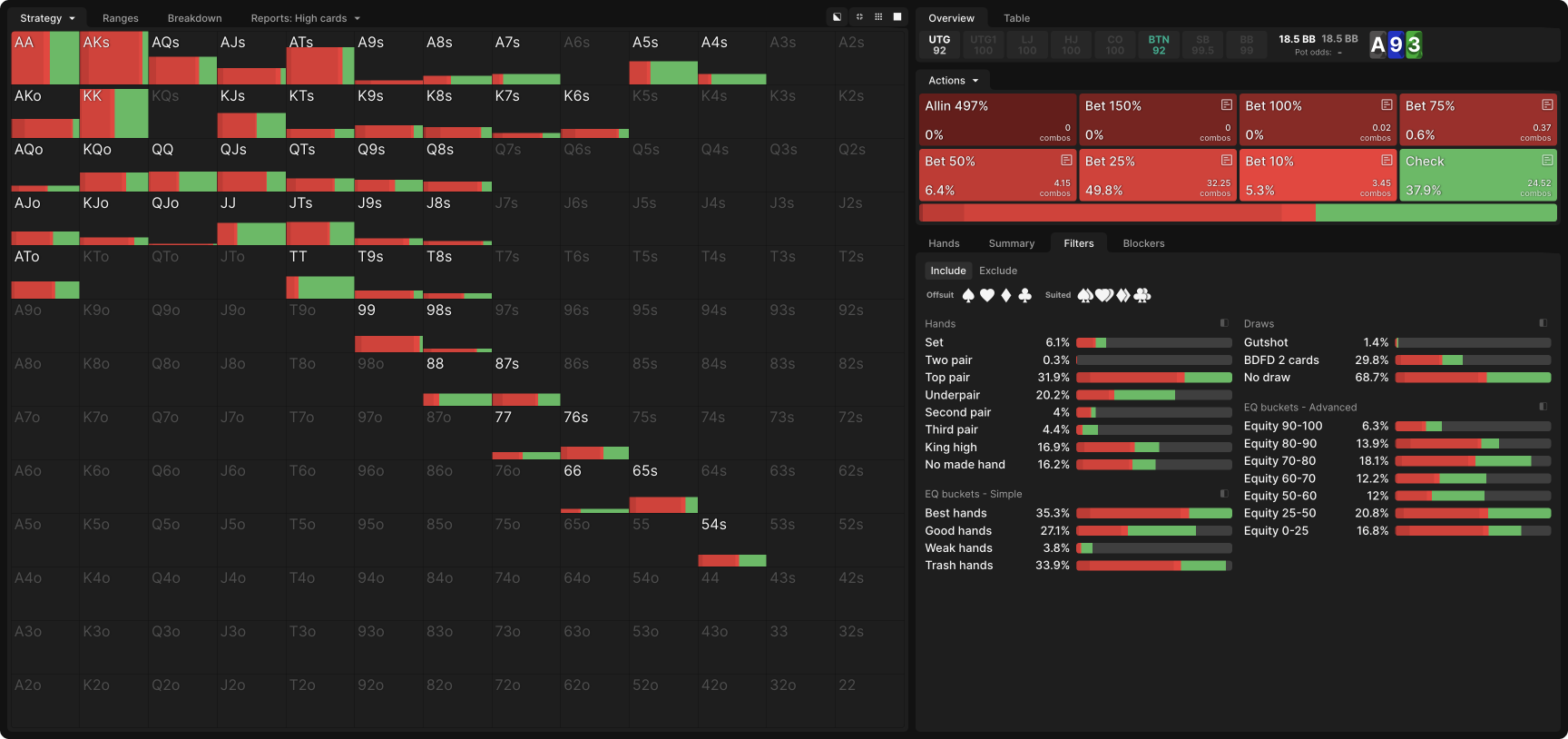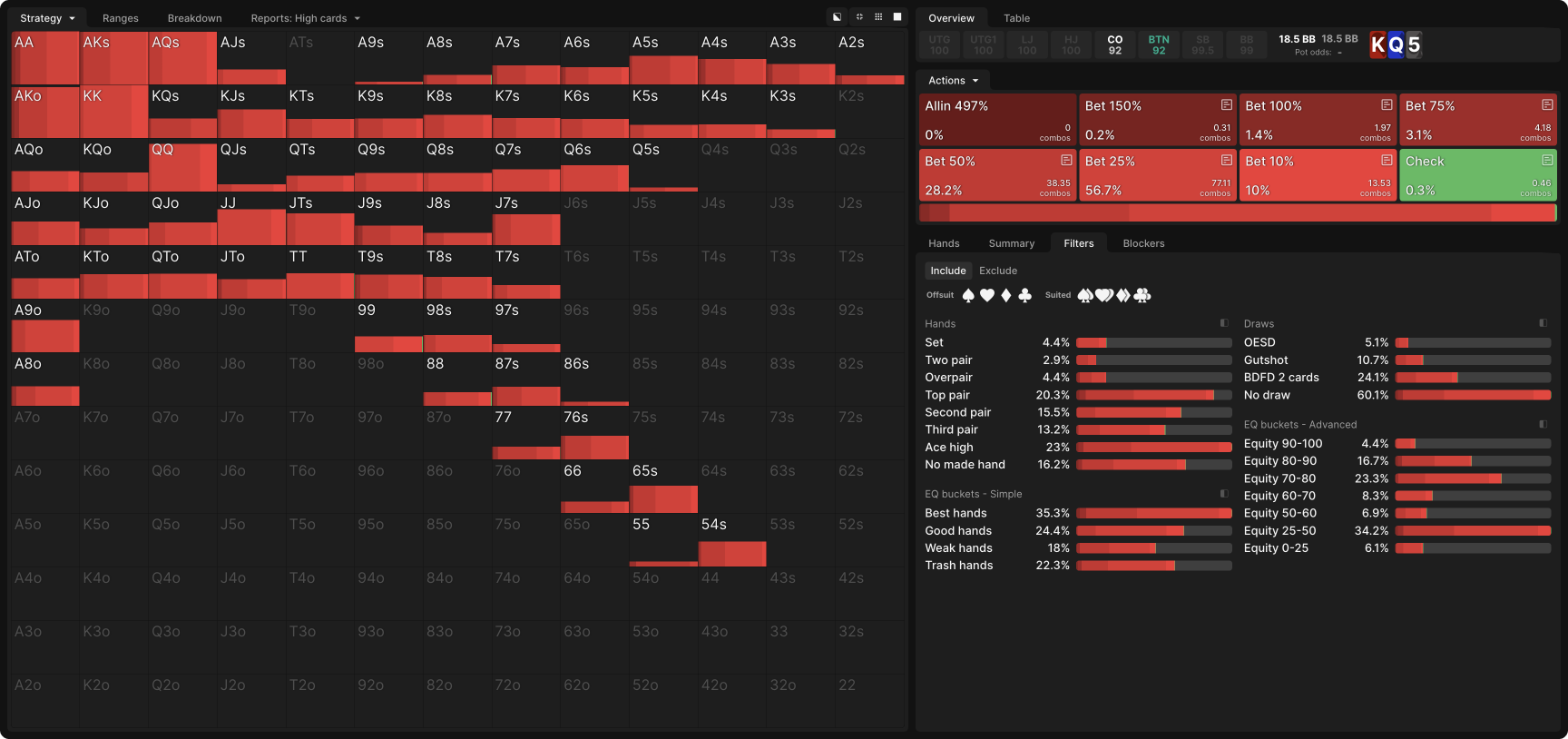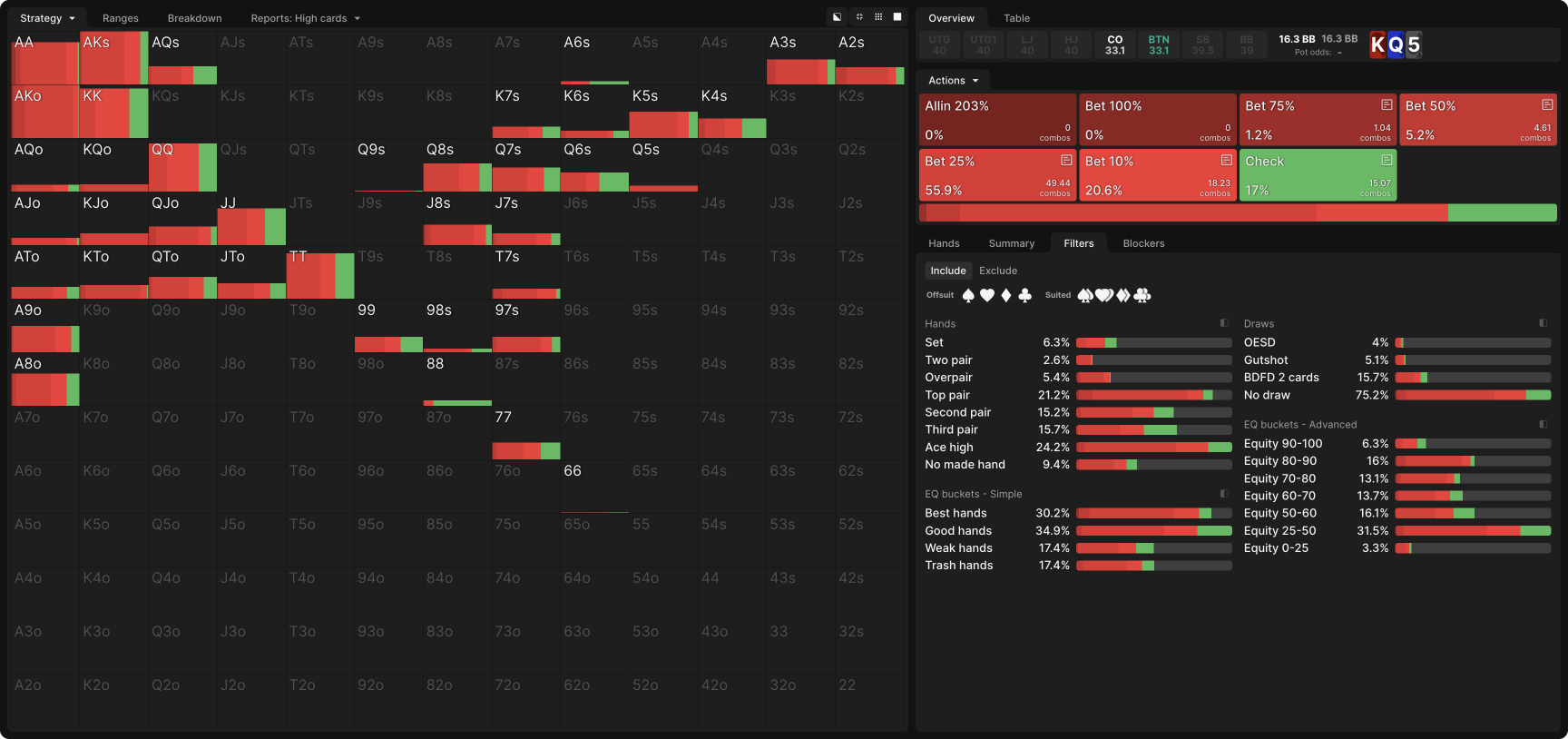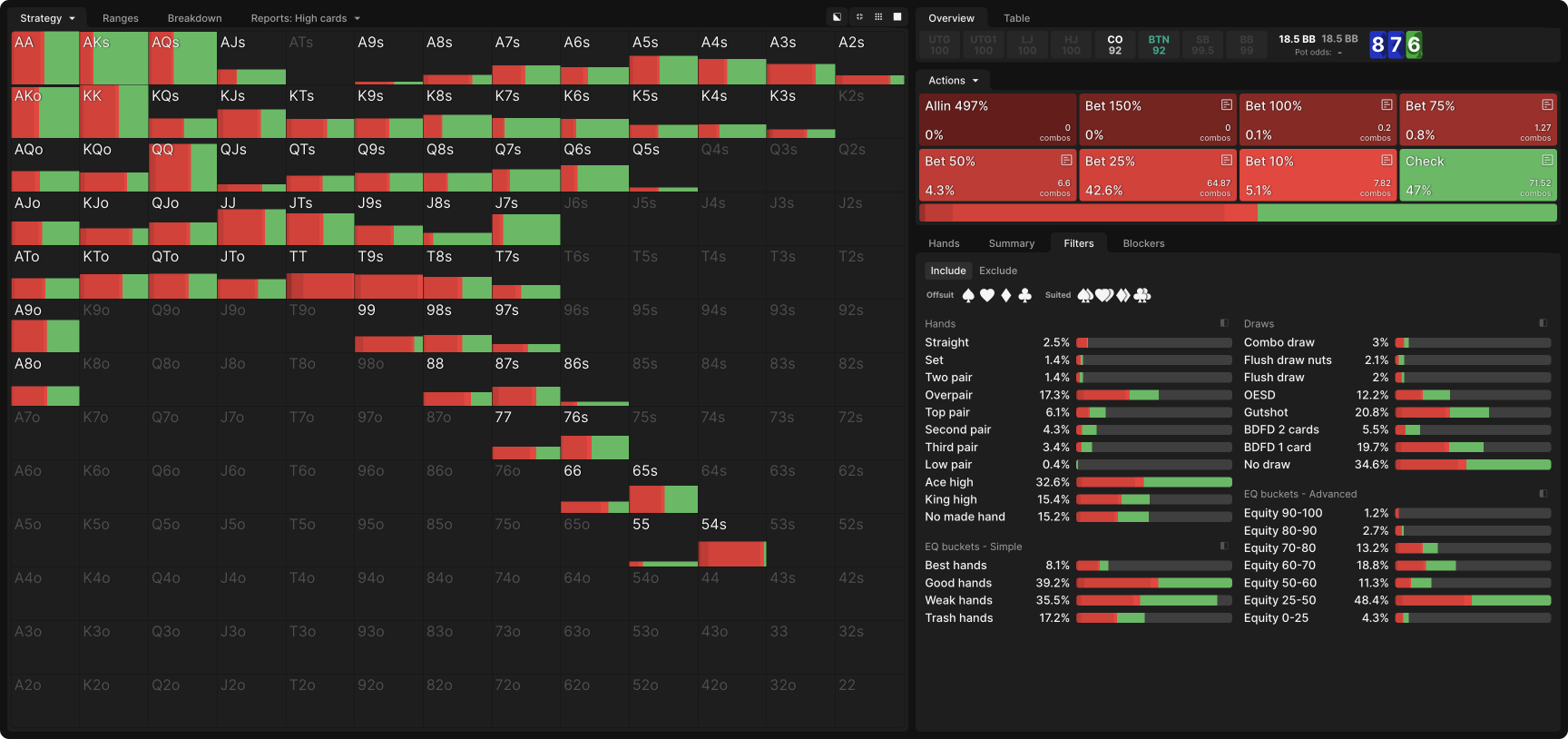C-Betting IP in 3-Bet Pots

Having invested a considerable number of chips in your three-bet and faded several worst-case scenarios, you can expect to enjoy both an equity advantage and a positional advantage post-flop. As a result, you will get to play aggressively and over-realize your equity on most flops.
When you three-bet before the flop and the original raiser calls from out of position, you have already enjoyed some good luck. True, much of your three-betting range would have preferred to take it down immediately. However, getting to play heads up after the flop in position is a nice consolation prize. For all but your strongest hands, it is a better outcome than facing a four-bet from the original raiser or, horror of horrors, a cold four-bet.
In this article, we will look at how best to do that: which bet sizes to use, when you should not bet at all, and more.
As mentioned above, positions do not make a big difference. The trends are the same for most scenarios, regardless of position. When the BTN three-bets the CO, they will play most flops similarly to how they would if they had three-bet against UTG.
This is because the three-better modulates their preflop raising strategy based on the strength of the original raise, and the original raiser similarly modulates their calling strategy. When the open raise comes from the CO, that’s a much wider range than when it comes from UTG. The BTN compensates by three-betting a wider range than they would against UTG, and CO continues to that three-bet with a wider range. So, the relative differential between their ranges remains similar.
An early position three-bet takes on additional risk that a late position three-bet does not.
When the three-bet comes from earlier position, that makes a bigger difference, because an early position three-bet takes on additional risk that a late position three-bet does not. UTG1 must three-bet a tighter range against an UTG open than BTN would because they have more players behind them who would wake up with four-betting hands. Again, UTG compensates for this by calling a bit tighter against UTG1 than they would against BTN, so the difference is not huge.
Stack sizes, however, make a big difference. The three-better mostly bets smaller and more often as stack sizes get shallower. In addition to their positional advantage, the three-better will enjoy a nuts advantage on most flops. This is because they are more likely to hold big pocket pairs and big broadway cards like AK that can flop strong pairs. Their three-bet mostly serves to get the SPR for the flop below 4, at which point they can treat these strong pairs as the nuts on most boards.
Despite the low SPR, they want to take advantage of leverage by spreading their bets across three streets. This both sets them up to access stacks on the river when they wish to do so (whether for value or as a bluff) and puts tremendous pressure on their opponent’s medium-strength hands, which must account for the risk of that river shove when responding to bets on earlier streets.
With shallow stacks, that means betting tiny–often 25% pot or less–on the flop so they have room for small bets on the turn and river as well. With deeper stacks, it requires slightly larger flop bets–50% starts to become more common–to get all the money in with similarly sized turn and river bets.
Blank Flops
The three-better arrives at the flop with a significantly stronger range than the original raiser, so flops that miss both players effectively cement that preflop equity advantage. We will take, for our example, a 552r flop.
BTN will leverage their big pair advantage to bet a polar range on the turn and river and so benefits from growing the pot to set up a river shove.
Even with 100bb starting stacks, a BTN three-better doesn’t have to worry about running into many trips or better from an UTG opener and so can bet with abandon:
Notice the heavy use of the 50% and 75% sizes. On most runouts, BTN will leverage their big pair advantage to bet a polar range on the turn and river and so benefits from growing the pot to set up a river shove with these effectively nutty hands.
A CO opener will have more 5x and 22 in their calling range, so a BTN three-better proceeds with more caution against them:
Against CO, BTN checks more often and moves away from the 75% and 50% bets toward the 25% pot option.
This remains a very favorable scenario for them, however. The equities are split roughly 50/50, but BTN realizes 10.78bb in EV to CO’s 7.72bb. This is leverage and a polarized range in action:
With 40bb stacks, the presence of trips or better in CO’s range is no longer a concern. That doesn’t mean they aren’t there, just that BTN can more comfortably treat their pocket pairs as the nuts at this lower stack depth. They continuation bet their entire range, just as in the 100bb BTN v UTG scenario, but now prefer a smaller size because of the shallower stacks:
The hands that bet 50% pot (the larger size, in this scenario) are not BTN’s strongest. In other words, this is not a nuts-or-air bet, as larger bet sizes sometimes are. With such shallow stacks, relatively invulnerable nut hands like KK and AA want to bet smaller to induce additional action, as they will be strong enough to continue betting for value on later streets and can get stacks in easily by the river despite the small flop bet.
The hands betting 50% pot are strong but vulnerable hands: JJ, TT, even A2s, and AKo fall in this category. These hands benefit from denying equity but still expect to be ahead when the flop is called. However, on many turns, they will not be able to continue value betting, so they prioritize putting in more money on the flop.
Ace-High Flops
Ranges in three-bet pots tend to be heavy on Ax hands, making strategy for Ace-high flops tricky. If you don’t have an Ace, there’s a good chance your opponent does. Additionally, Ace-high flops are among the most static because no higher card can come. As a result, the three-better tends to do a lot of checking or tiny betting, depending on the extent of their range advantage. Ace-high flops are quite favorable for them; it’s just that a big chunk of their range–hands like KK, QQ, and weaker Ax–don’t have much to gain from betting.
Ace-high flops are among the most static.
For example, here is the 100bb strategy for a BTN v UTG confrontation on A93r:
BTN has 55% of the equity yet checks quite often and sticks to a small size when they do bet. Notice that these checks are mostly pocket pairs and weaker Ax, the hands that can’t deny much equity and don’t want to play large pots. For strong hands like AQ, AK, and especially AA, it’s hard to shovel money in because of the blocking effect on UTG’s call-down range. In fact, the hand BTN bets most consistently is 99, which is their only extremely strong hand that unblocks UTG’s Ax region.
In a 100bb UTG1 v UTG confrontation, the three-better’s equity advantage exceeds 60%. They don’t check much in this scenario, but the check is mostly replaced by a 10% pot bet, so they aren’t exactly shoveling money in, either:
With shallower stacks, the small bets can be even smaller. With 40bb starting stacks, the BTN three-better bets 10% pot with more than half their range into an UTG caller:
Two Broadway Flops
Big cards on the flop tend to make hand values more static, and this is especially true in three-bet pots, where big cards predominate in both players’ ranges. So, continuation betting strategy on these boards looks similar to Ace-high flops, with many small bets and checks from medium pairs. Here is BTN v CO on KQ5r with 40bb effective stacks:
Deeper stacks accentuate the three-better’s nuts advantage, enabling them to bet their modest hands and start sizing up with a more polar range. Here is BTN v CO with 100bb stacks:
Deeper stacks accentuate the three-better’s nuts advantage.
Depending on the runout, some medium-strength hands that bet flop can turn into bluffs on later streets. The deeper stacks enable BTN to leverage their nuts advantage for a very high bluffing frequency on flop and turn, allowing for bluffs even with unideal candidates like small pocket pairs.
The same scenario with 40bb effective stacks sees more checking from these hands:
Checking medium-strength hands is also safer because shallower stacks limit the pressure CO can apply with polarized bets on the turn and river.
Medium Connected Flops
Medium connected flops like 876tt have a lot in common with low paired boards like 552r. Equities are split roughly 50/50, but the prevalence of unpaired overcards in the three better’s range and the risk of nutty hands in the caller’s range compels a lot of checking back. Here is the 100bb BTN v CO strategy on 876tt, which is quite similar to the BTN v UTG strategy:
There’s a lot of mixing, but some heuristics stand out. Straights are pure bets for the same reason so many medium hands check: this is an easy flop for the caller to check-raise. The other frequently bet hands are draws and strong-but-vulnerable pairs, especially when they are also draws (TT, 99).
With 40bb stacks, BTN doesn’t have many straights, but this doesn’t really change their betting frequency. They compensate by betting more overpairs, which can more comfortably stack off with a low SPR:
This highlights some of the reasons why many players consider these coordinated flops a nightmare (as the three-better, anyway):
- With shallower stacks, they see too many monsters under the bed and are reluctant to play their overpairs strongly.
- With deeper stacks, they construct their three-betting ranges poorly. When stacks are too deep to treat overpairs as the nuts on many flops, you need to three-bet a more diverse range so that you can flop nuts on boards like 876tt.
Conclusion
The stack depth should also determine the size of these bets. When possessing a nuts advantage, the three-better structures the betting so they have the option to put stacks in across all three streets. With shallow stacks, this can mean continuation bets as small as 10% of the pot to leave room for betting the turn and river. With deeper stacks, they may prefer larger (but still rarely more than half-pot) bets, so they will not need to overbet later streets to get stacks in. Strong-but-vulnerable hands are the best candidates for these larger bets, as they won’t be able to keep value betting on many runouts, and so should prioritize putting more money in sooner.
An awareness of the stack-to-pot ratio and the composition of your own range is essential to playing well in three-bet pots. The biggest difference between the three-better’s range and the caller’s is generally the prominence of big pairs and the biggest unpaired hands. When circumstances permit playing these hands strongly, the three-better should continuation bet more frequently.
Author
Andrew Brokos
Andrew Brokos has been a professional poker player, coach, and author for over 15 years. He co-hosts the Thinking Poker Podcast and is the author of the Play Optimal Poker books, among others.
